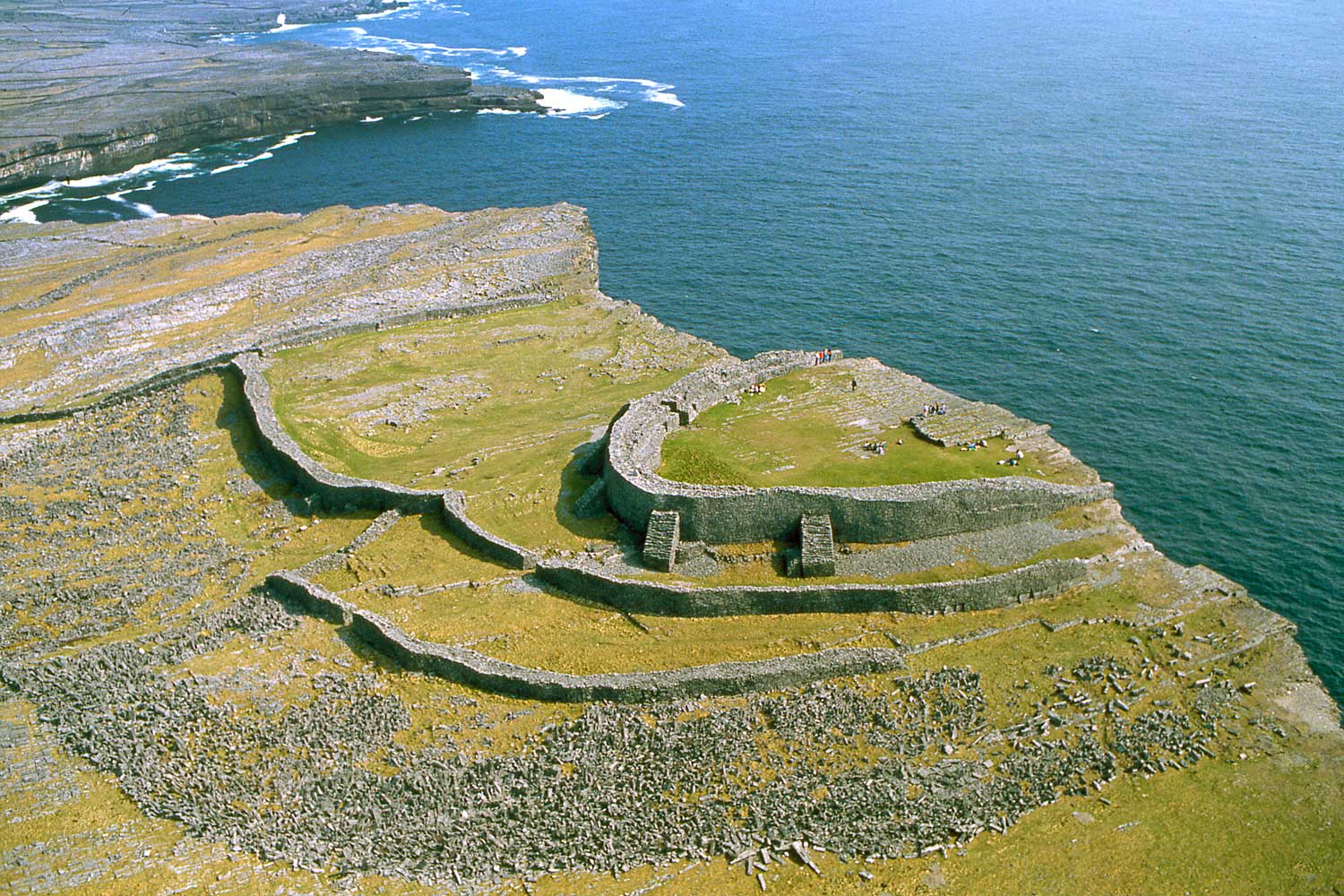Dún Aonghasa

Location: Cill Mhuirbhigh, Co. Galway
Classification: Cliff Edge Fort
SMR Code: GA110-039----
Rating:
Dún Aonghasa (anglicized Dun Aengus) is the best-known of several prehistoric hill forts on the Aran Islands of County Galway, Republic of Ireland. It lies on Inishmore, at the edge of a 100-metre-high (330 ft) cliff. A popular tourist attraction, Dún Aonghasa is an important archaeological site. The fort consists of a series of four concentric walls of dry stone construction. The original shape was presumably oval or D-shaped but parts of the cliff and fort have since collapsed into the sea. Outside the third ring of walls lies a defensive system of stone slabs, known as a cheval de frise, planted in an upright position in the ground and still largely well-preserved. These ruins also feature a huge rectangular stone slab, the function of which is unknown. Impressively large among prehistoric ruins, the outermost wall of Dún Aonghasa encloses an area of approximately 6 hectares (14 acres).
Sea levels were lower when Dún Aonghasa was built and occupied during the Bronze Age and its residents may have looked out onto a wide stretch of rocky foreshore. Excavations at the site indicate that the first construction goes back to c.1200 BC, when the first enclosure was erected by piling rubble against large upright stones. Around 500 BC, the triple wall defences were probably built along the western side of the fort. Although clearly defensible, the particular location of the fort suggests that its primary purpose was civil and ceremonial rather than military. Dún Aonghasa was also a centre for bronze casting, producing one of the largest collections of late Bronze Age clay moulds recorded in Ireland or Britain. Swords, spearheads, knives, bracelets, pins and axes were cast there.
The 19th-century artist George Petrie called Dún Aonghasa "the most magnificent barbaric monument in Europe". Its name, meaning "Fort of Aonghas", may refer to the pre-Christian deity, Aengus Óg. However, Irish mythology and folklore suggest that the great fort was home to Aonghus mac Úmhór, the last Fir Bolg King of Connacht. Aonghus led his people, the Tuath mhac nUmhoir, to the coast of Galway Bay and the Aran Islands, after being driven out by warfare with the Gaels. The fortress of Dún Aonghasa on Inishmore, which legend states he built, is still called after him.
Description
Dún Aonghasa (anglicized Dun Aengus) is the best-known of several prehistoric hill forts on the Aran Islands of County Galway, Republic of Ireland. It lies on Inishmore, at the edge of a 100-metre-high (330 ft) cliff. A popular tourist attraction, Dún Aonghasa is an important archaeological site. The fort consists of a series of four concentric walls of dry stone construction. The original shape was presumably oval or D-shaped but parts of the cliff and fort have since collapsed into the sea. Outside the third ring of walls lies a defensive system of stone slabs, known as a cheval de frise, planted in an upright position in the ground and still largely well-preserved. These ruins also feature a huge rectangular stone slab, the function of which is unknown. Impressively large among prehistoric ruins, the outermost wall of Dún Aonghasa encloses an area of approximately 6 hectares (14 acres).
History
Sea levels were lower when Dún Aonghasa was built and occupied during the Bronze Age and its residents may have looked out onto a wide stretch of rocky foreshore. Excavations at the site indicate that the first construction goes back to c.1200 BC, when the first enclosure was erected by piling rubble against large upright stones. Around 500 BC, the triple wall defences were probably built along the western side of the fort. Although clearly defensible, the particular location of the fort suggests that its primary purpose was civil and ceremonial rather than military. Dún Aonghasa was also a centre for bronze casting, producing one of the largest collections of late Bronze Age clay moulds recorded in Ireland or Britain. Swords, spearheads, knives, bracelets, pins and axes were cast there.
Folklore
The 19th-century artist George Petrie called Dún Aonghasa "the most magnificent barbaric monument in Europe". Its name, meaning "Fort of Aonghas", may refer to the pre-Christian deity, Aengus Óg. However, Irish mythology and folklore suggest that the great fort was home to Aonghus mac Úmhór, the last Fir Bolg King of Connacht. Aonghus led his people, the Tuath mhac nUmhoir, to the coast of Galway Bay and the Aran Islands, after being driven out by warfare with the Gaels. The fortress of Dún Aonghasa on Inishmore, which legend states he built, is still called after him.
Accessibility Rating: Easy - Moderate
About 1km walk from the Dún Aonghasa Visitor Centre.
Dún Aonghasa Visitor Centre, Aran, Co Galway. Telephone No: +353 99 61008
Accessibility
Accessibility Class: Easy - Moderate
About 1km walk from the Dún Aonghasa Visitor Centre.
Facilities
Dún Aonghasa Visitor Centre, Aran, Co Galway. Telephone No: +353 99 61008
Map
Users should note that the Monumental Ireland application and website are information guides only and do not act as an invitation to enter any of the properties or sites listed. No responsibility is accepted by the creators of the Monumental Ireland application for any loss, injury or inconveniences sustained as a result of using it.











